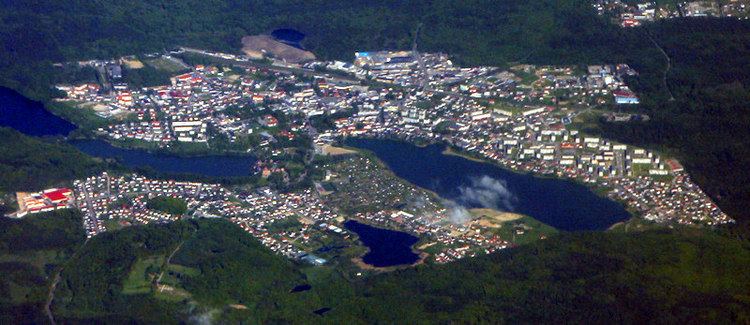Town rights 1923 Area 6.23 km² | County Kartuzy County Established 1391 Elevation 42 m (138 ft) Population 15,263 (2006) Local time Friday 7:57 PM | |
 | ||
Weather 3°C, Wind W at 14 km/h, 87% Humidity Points of interest Muzeum Kaszubskie im Franci, Kościół pw Św Kazimierz, Muzeum Kaszubskie | ||
Kartuzy [karˈtuzɨ] (Kashubian/Pomeranian: Kartuzë; German: Karthaus) is a town in the historic Eastern Pomerania (Pomerelia) region of northwestern Poland. Previously in Gdańsk Voivodeship from 1975 to 1998, Kartuzy since 1999 is the capital of Kartuzy County in Pomeranian Voivodeship since 1999.
Contents
- Map of Kartuzy Poland
- Geographical location
- History
- Coat of Arms
- Population by year
- Sports
- Local writers and artists
- Twin towns sister cities
- References
Map of Kartuzy, Poland
Geographical location
Kartuzy is located about 32 kilometres (20 miles) west of Gdańsk and 35 km (22 miles) south-east of the town of Lębork on a plateau at an altitude of approximately 200 metres (656 feet) above sea level in the average. The plateau, which is divided by the Radaune lake, comprises the highest parts of the Baltic Sea Plate. In the west of this lake are the highest points of the headwaters of rivers Leba, Slupia and Bukowina at an altitude of up to 271 metres (889 feet). A hill in the south of the lake is 331 metres (1,086 feet) high.
History
Kartuzy was established about 1380 as a monastery for Carthusian monks descending from Prague in the Kingdom of Bohemia, after whom it received its name. The charterhouse was vested with large estates by the State of the Teutonic Order. According to the Second Peace of Thorn the area passed to the Polish Crown and it became part of Royal Prussia in 1466.
The Carthusian monks had the nearby woodlands cleared out, and peasants from the neighbouring Duchy of Pomerania were encouraged to settle and farm in the newly cleared areas. During the course of the Protestant Reformation Kartuzy and its surrounding area were incorporated into the possessions of Cistercian Oliwa Abbey in 1565. The area was annexed by Prussia in the First Partition of Poland in 1772. The Prussian government finally dissolved the monastery in 1826. Around that time the settlement of Karthaus was fairly insignificant. It begun to play a greater economic role after 1841 when the lands of the monastery were parcelled out.
Until 1919 Karthaus belonged to Kreis Karthaus in the Province of West Prussia in the administrative district of Regierungsbezirk Danzig of the German Reich. At the turn from the 19th to the 20th century the town had a Protestantic church, a Catholic church and a synagogue. The town was appreciated as a climatic type of health resort. Many pensioners and other retired persons settled down here.
When after World War I the regulations of the Treaty of Versailles became effective in 1920, Kartuzy was integrated into the Second Polish Republic. During the time span 1939–1945 Karthaus belonged to the administrative unit of Reichsgau Danzig-West Prussia, Regierungsbezirk Danzig, of Germany's Third Reich. At the end of World War II Karthaus was occupied by the Red Army. After the war the region was put under the administration of the People's Republic of Poland.
Kartuzy has long been a cultural center of the Kashubians. Since 1947 a Kashubian Museum has featured numerous exhibits connected to Kashubia and its inhabitants. The town has also set up a bust to honor Dr. Aleksander Majkowski, author of The Life and Adventures of Remus, who practiced medicine in Kartuzy for a time and is buried here. In 2010, the Kashubian Unity Day was held here. On March 28, 2010 after the Holy Mass in the fourteenth-century collegiate church, Kashubes in colorful regional costumes with black-and-yellow flags passed through the streets to the Team of Schools No. 2 for Wybicki's Estate where the main celebrations were held.
Coat of Arms
A coat of arms for Kartuzy was designed by Dr. Aleksander Majkowski and accepted by the city council on January 31, 1923. The coat of arms depicts a black Kashubian Griffin and seven silver stars on a blue background.
Population by year
Sports
Local writers and artists
Kartuzy was the home town of the writer Aleksander Majkowski. Right before World War II it was also the home town of Kashubian writer and activist Jan Rompsczi.
Since 2012 a quarterly literary Światło i Cień has been published which brings together local writers and artists.
Twin towns — sister cities
Kartuzy is twinned with:
